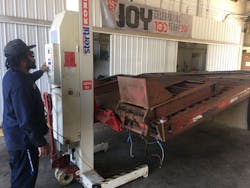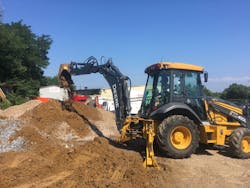From Marine to Mentor in Equipment Management
Les Hill, CEM, fleet manager at B.F. Joy in Hyattsville, Maryland, isn’t the type to panic.
“If something bad happens, my response is, well, good,” he says. “Good. It’s an opportunity to learn. It’s maintaining that positivity and making sure that if there’s any deficiency with your people, you’re doing everything you can to help them grow.”
As one would guess, Hill is a big believer in mentoring and training. He received plenty of both as a former assistant fleet manager at Lane Construction, and as a Marine who completed two tours in Afghanistan. He is fluent in Pashtu and two other Afghan dialects, and spent time in Marine intelligence, where he learned to analyze data.
Under 40 in Construction Equipment
This is another in a series of profiles highlighting winners, past and present. Click here to nominate a young leader under 40 years old.
That is just one skill he brings to his job at Joy, a $40-million-per-year underground contractor specializing in “dry” utilities such as electric, fiber, and gas. The Washington, D.C., metro-area contractor has also diversified into more subcontracting work, installing manholes, conduit, and pipe in the ground for building projects.
Fresh on the job as of January this year, Hill has brought a leadership style that echoes his time in the Marine Corps. But he’s soft-spoken—not at all like a drill sergeant.
“Yes, there’s the old saying, ‘Opportunity knocks where responsibility is abdicated,’” Hill says. “Sure, whenever you see something not happening, you call it out loud and get it done quickly; there is some truth there.
“But, I’ve learned that it’s not always the loudest voice in the room that defines leadership. I tell my people that we’re in this journey together. In the Marine Corps, I was an enlisted man, but the sergeants would say, ‘My Marines are a reflection of me, of my leadership.’ Like that, I have to own everything, and that’s the approach I take.
“If they succeed or fail, that’s on me,” Hill says. “And it’s on me to mentor them, to give them every opportunity to succeed.”
When Hill (right) started in his position, he noticed a somewhat adversarial culture.
“The No. 1 culture factor I saw when I came here is that it was us versus them with the fleet,” Hill says. “Particularly between production and the fleet. The fleet kind of had a chip on its shoulder, saying [production is] always talking bad about us, but they’re the ones creating the problems.
“So they were a little shocked when I came in here and said we’re only here to add value. That is our total existence, to add value,” Hill says.
“These guys can go get their trucks on their own, they can go get service on their own, they might pay a little more for it, and that’s the difference we make,” Hill says. “If we’re not saving them money, if we’re not adding value to their operation, there’s no reason for us to be here. We are support.”
Hill likens the concept to the Marines, in which he says you are either infantry or you’re support; infantry is out pulling the trigger and kicking down doors, and everyone else feeds into infantry’s mission with things like intelligence and protection.
“Production is out there taking in the dollars,” Hill says. “We don’t really make any money in fleet. We’re saving money and protecting the company. Getting that perspective into them was a shock. With that shock, there had to be that balance of love and accountability. I had to come in and start building relationships with these guys so they saw ‘Hey, I care about you and I’m going to do something for you and let you know that I care. But at the same time, I’m going to hold you accountable.’
“You can’t really have a relationship without that. I’ve really tried to bring in that brotherhood aspect in the way that I make bigger demands for our department. Here we have this big goal, this is how we’re going to accomplish it. There will be nonbelievers, but you follow that up with consistency on the plan, and you constantly give the credit to the people who are doing the work, making sure they’re recognized.”
As Hill built his team, he also took a deep dive into equipment costs for his fleet, which has a $1.7 million ERV and consists of 100 on-road vehicles ranging from F-150 pickups to dump trucks, eight leased backhoes, four rented mini excavators, and a wide variety of smaller equipment, including trailers, arrow boards, air compressors, and light plants.
Hill inherited a number of five-year leases, which he classifies as long-term. “Basically, we’re trying to make the fleet a little more agile so we can cut our ownership costs by say 20 percent when needed, whenever the work slows down,” Hill says. “Part of that strategy going forward is to maintain a level of rentals in the fleet that I can cut off if needed. Right now, the rental market in this area, sometimes I can rent cheaper than I can lease because it’s so competitive. The plan is to rent more on the yellow side for agility once we get off the five-year leases. I’d like to purchase more on the light pickup truck side, with a goal of keeping for two years, then replenishing.”
Hill has improved the company’s overall vendor relations and procurement decision strategy, already achieving a 40-percent decrease in outside rental costs, and a 32-percent decrease in acquisition costs. One way he’s continuing is by keeping a sharp eye on rental rates, something that wasn’t always done.
Equipment acquisition strategies
“There wasn’t really a policy in place and we were paying through the nose for shoring, and some of the rental rates were just crazy,” he says. “Some of the rental companies were taking advantage of the people who were calling to rent with them.
“There was one job where we had shoring that started out $190 a month per shore, and by the end of that seven-month rental, they were charging $390 per shore. Nobody was watching them; no one had the time to watch them,” Hill says.
“I was successful at Lane getting low rates because I shop around to get the best price I can. Just in what we’ve rented so far this year, we’ve saved $175,000 versus the rates from last year. You can’t reach out to the same three guys for quotes every time.”
Hill says the key is to get more quotes, pick a price, and take it back to your sources for a second round.
“The way I do it is to go and get five or six quotes, then I take the lowest one and I go back to all of them, not saying who it’s from, and say, ‘This is the lowest price I have, can you guys beat it?’” Hill says. “Everybody has room to work—it’s just figuring out where it is. And they want your business. In this market, that’s how I’ve gotten [rental] rates that beat lease rates.
“When I got here, we were paying $4,000 for a mini excavator with a hammer on it, now I’m paying $1,900 for the same thing,” Hill says. “It’s just one of those things, when you do your due diligence and stay on top of it, you can do it. Part of what I’ve come to see is that it’s really the systems behind everything. Making the administrative work and those systems efficient allows your people the time to watch those things, and properly negotiate those things.”
Hill has also attacked the cost of idling, particularly among his drivers, and he is looking to have telematics play a greater role in driver behavior going forward.
“For on-road, we use a system called GPS Trackit,” he says. “It’s a pretty basic system that gives you location, and you can do a crumb trail of where a vehicle’s been. It also gives you hard braking, hard turning, and hard acceleration for driver behavior. I’m not fully satisfied in the way it reports, but it’s what was here. They’ve already made a pretty significant investment in the hardware, so it’s hard to switch and try to go to something else without showing why, but that’s an investigation I’m going into here.”
Hill says his perfect system will include a dispatch component, along with driver behavior monitoring, driver scorecards, and even a mechanism to add in the costs of drivers’ habits on wear and tear, fuel burn, and mileage.
Control idling costs
Regarding idling, Hill used the existing telematics system to gather data on idling time for his on-road fleet. “I did a projection and showed what idle time is costing us in fuel, just based on manufacturers’ burn rates and how much fuel idling is wasting,” he says. “I gave it to each of the gentlemen who are out there running the work, construction managers, contract leads, division managers. Once I built the tool, it was just a matter of dumping the data in.
“They were surprised to see the costs associated with idling,” Hill says. “I reinforced it every day by having our dispatch managers pulling those reports, putting them into a spreadsheet with the fuel used and the costs—it was immediate feedback.” The managers took it well.
“One of the groups even asked me to present the results directly to their drivers,” Hill says. “What’s tough here is that historically, fuel has been included in the equipment rate. So managers aren’t incentivized to save fuel. They’re paying $5.50 an hour for a pickup truck, and that covers everything, so they don’t feel the effects directly. On the fleet side, we have to get the recovery we need to cover our fuel costs.”
Recovery has been a major focus since Hill arrived at B.F. Joy.
“At first I noticed we were averaging around $12,000 to $14,000 low each week on recovery versus where we wanted to be,” he says. “We had a big deficit when it came to recovery. The knee-jerk reaction would be to raise rates, right? Because we’re not getting the utilization, we’re not getting the hours we need.
“I love [Construction Equipment contributing editor] Mike Vorster; his thing is if utilization is low, the rate’s got to be high, because you have to recover your cost,” Hill says. “So what I did was go around and research how things were done here, looked at historical standard operating procedures (SOPs) and I came up with an SOP that I educated everyone on leading up to June 1. Now for June, we were $15,000 ahead. We still have a hole, but we’re on pace to dig ourselves out.”
Consistency is the key, according to Hill.
“We had to start out with making sure how we record utilization is consistent across the board,” he says. “And some of the concerns were, if you see it’s over, you’re collecting too much, so this SOP is too aggressive, and you have to adjust it. Well, the answer to that is no. I’m not going to adjust the SOP, I’m going to adjust the rates. Because you set the standards and practices up front, you get everybody used to those, and accustomed to them.
“You tell them these are the rules, here’s how to report hours on equipment, and you keep that as rock solid as you can; you want everybody to be consistent,” Hill says. “And then you adjust the rates where they need to be, because the rates are the easiest thing to adjust. You can go in and change the numbers as long as we’re factoring ownership and operating costs effectively. We know what we need to get. So when we see we’re over at the end of the year, we lower equipment rates. Because everybody wants lower rates.”


